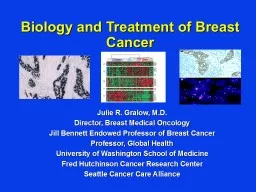

Julie R Gralow MD Director Breast Medical Oncology Jill Bennett Endowed Professor of Breast Cancer Professor Global Health University of Washington School of Medicine Fred Hutchinson Cancer Research Center ID: 779050
Download The PPT/PDF document "Biology and Treatment of Breast Cancer" is the property of its rightful owner. Permission is granted to download and print the materials on this web site for personal, non-commercial use only, and to display it on your personal computer provided you do not modify the materials and that you retain all copyright notices contained in the materials. By downloading content from our website, you accept the terms of this agreement.
Slide1
Biology and Treatment of Breast Cancer
Julie R. Gralow, M.D.Director, Breast Medical OncologyJill Bennett Endowed Professor of Breast CancerProfessor, Global HealthUniversity of Washington School of MedicineFred Hutchinson Cancer Research CenterSeattle Cancer Care Alliance
Slide2Breast Cancer Biology: Not all Breast Cancers are the Same!!
Estrogen Receptor (ER) + 75% of Breast CancerHER-2 +20-25% of Breast CancerTumor ER and HER2 status are CRITICAL in selecting therapy in both early stage and metastatic breast cancer!
Slide3Breast Cancer Biology: Triple Negative Breast Cancer (TNBC)Breast cancer that does not express:Estrogen Receptor (ER)Progesterone Receptor (PR)
HER-215 to 20 percent of breast cancersVirtually always high gradeCommon in BRCA1 mutation carriers (over 80%)Overrepresented in premenopausal and African womenPoor prognosisSensitive to chemotherapy
Slide4Determining ER and HER-2 StatusTissue Processing: Each Step Matters!
Cold ischemia time: time from tissue removal to placement in fixative
Fixation parameters: type of fixative and duration
Slide5Breast Cancer Treatment:
A Multidisciplinary Team ApproachRadiologyPathologySurgeryRadiation OncologyMedical OncologyFighting the Crab – Kiev, Ukraine
Slide6Breast Cancer Systemic TherapiesDrug treatments that can attack cancer cells throughout the bodyEndocrine
(hormonal) therapyChemotherapyTargeted therapy
Slide7Estrogen Receptor as a Target for Therapy
EstrogenCell Growth and Division
Estrogen Receptor
SERMS (tamoxifen),
SERDS
Aromatase inhibitors, ovarian suppression
Endocrine therapy is effective only in ER-positive breast
cancer
Slide8WHO Model List of Essential Medicines 19th Edition (April 2015)Endocrine therapy:Tamoxifen
Anastrozole (Arimidex) – aromatase inhibitor, postmenopausal onlyLeuprolide (Lupron) – ovarian suppression, premenopausal onlyAntineoplastic drugs relevant to breast cancerhttp://www.who.int/medicines/publications/essentialmedicines/en/
Slide9WHO Model List of Essential Medicines 19th Edition (April 2015)Chemotherapy:Doxorubicin
(Adriamycin)Cyclophosphamide (Cytoxan)Paclitaxel (Taxol)Docetaxel (Taxotere)Fluorouracil (5-FU)MethotrexateCarboplatinGemcitabine (Gemzar)Capecitabine (Xeloda)Vinorelbine (Navelbine)Antineoplastic drugs relevant to breast cancerhttp://www.who.int/medicines/publications/essentialmedicines/en/
Slide10HER-2 as a Target for Therapycell division
HER-2
nucleus
cancer cell
Trastuzumab
Anti-HER-2 Antibody
Lapatinib
Dual HER-1/HER-2 Tyrosine Kinase Inhibitor
Pertuzumab
Anti-HER-2 Antibody
T-DM1
Ado-
trastuzumab
emtansine
Antibody-Drug Conjugate
Slide11WHO Model List of Essential Medicines 19th Edition (April 2015)Targeted TherapyTrastuzumab
(Herceptin)Antineoplastic drugs relevant to breast cancerhttp://www.who.int/medicines/publications/essentialmedicines/en/
Slide12Targeting the Cancer EnvironmentIn Addition to Targeting the Cancer Cell, We Can Also Target the Cancer Environment
Cancer cell
Immune cell
Blood vessels
Fibroblast
Osteoclast (bone cells)
Slide13Targeting the Cancer Environment: Bone Inhibition
cancer cells
osteoclasts
osteoblasts
, macrophages
Drugs that block bone destruction:
Bisphosphonates (
zoledronic
acid,
pamidronate
)
RANK ligand inhibitor (
denosumab
)
Slide14Goals in the Treatment of Breast Cancer Vary by Stage
Slide15Non-Metastatic Breast Cancer
Cancer confined to the breast and local lymph node areas
Slide16Treatment of Non-Metastatic Breast CancerGoal: CureBreast cancer is most curable
when detected earlyMicrometastases (undetectable) can exist at time of diagnosis in many patients, leading to eventual recurrenceMultidisciplinary care is critical for best outcomesSurgeryRadiation therapyAdjuvant systemic (drug) therapyReduces risk of recurrence and deathShould be tailored to the patient and tumor
Slide17Metastatic Breast Cancer
Cancer that has spread beyond the breast and local lymph node areas
Slide18Treatment of Metastatic Breast CancerGoals:Control and regression of disease
Prolongation of lifeImprovement in symptoms and quality of lifeMetastatic breast cancer is not currently usually curable, but is treatable
Slide19Quantity
of
Life
Quality
of
Life
Treatment of Metastatic Breast Cancer: A
Balancing Act
Balancing treatment efficacy and toxicity is a major objective
Slide20Choices in the Treatment of Metastatic Breast CancerTreatment is mainly with drug therapy that can
attack cancer throughout the bodyRadiation can be important (ie for pain control)Surgery uncommonChoice of treatment is based on many factors:Patient age, menopausal status, general health and functional statusTumor ER status, HER-2 statusPrevious treatmentsExtent and sites of diseaseAvailable therapies in the patient’s country
Slide21Biology and Treatment of Breast Cancer: ChallengesDespite important progress to date, cancer remains one of the world’s most serious health problems
Disparities in cancer care and survival remain significantWorldwide, new cancer cases and deaths continue to rise
Slide22Biology and Treatment of Breast Cancer: The FutureCancer care is set to change dramatically
in the next 10-20 years Advances in technology and a deeper understanding of cancer biology will transform cancer careContinued investments in cancer research required to translate scientific breakthroughs into new and affordable treatments
Slide23Biology and Treatment of Breast Cancer: SummaryMain principles of modern oncologyMultidisciplinary treatmentEvidence-based medicine
Individualized (tailored) therapyPrimary goals of therapyAdjuvant: curative intentMetastatic: incurable but treatableInclude psychosocial and supportive care and symptom-related interventionsInclude patient preferences and active participationPatients, families and caregivers should be invited to participate in decision-making